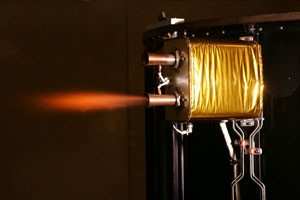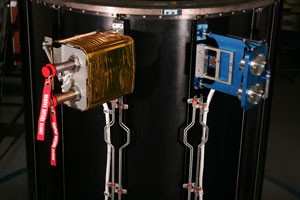Wed, Jun 24, 2009
New Propulsion System Will Keep 'Space Habitat' Aloft Using
Common Gasses
 Orion Propulsion, Inc.
Tuesday announced completion of a qualification test program for
the Forward Propulsion System (FPS) of Bigelow Aerospace’s
Sundancer Project, the world’s first commercial space
habitat. The Orion Propulsion thruster system uses hydrogen and
oxygen that are produced from Bigelow’s proprietary
Environmental Control Life Support System (ECLSS) as propellants
for the spacecraft’s attitude control system. This truly
“people-powered” space craft, which burns hydrogen and
oxygen generated from water, sweat, and urine, eliminates the need
for more toxic propellants such as hydrazine and nitrogen tetroxide
that are more costly to use and harmful to the environment - on
Earth and in space.
Orion Propulsion, Inc.
Tuesday announced completion of a qualification test program for
the Forward Propulsion System (FPS) of Bigelow Aerospace’s
Sundancer Project, the world’s first commercial space
habitat. The Orion Propulsion thruster system uses hydrogen and
oxygen that are produced from Bigelow’s proprietary
Environmental Control Life Support System (ECLSS) as propellants
for the spacecraft’s attitude control system. This truly
“people-powered” space craft, which burns hydrogen and
oxygen generated from water, sweat, and urine, eliminates the need
for more toxic propellants such as hydrazine and nitrogen tetroxide
that are more costly to use and harmful to the environment - on
Earth and in space.
Tim Pickens, CEO of Orion Propulsion, said, “We are
excited to complete this critical demonstration that will move
Bigelow Aerospace one step closer to creating a
self–sufficient commercial human habitat that is safer and
more environmentally friendly than any other system in use. I am
proud of our team for delivering a best-in-class solution for this
landmark project. We look forward to completing production and
flying critical flight hardware on the world’s first
commercial space habitat.”

“Orion Propulsion has been an excellent partner and has
met every delivery date and performance milestone,” said
Bigelow Aerospace Program Manager, Eric Haakonstad. “Their
team worked with our very specific and demanding requirements to
put together an elegant and “green” propulsion system
that is safe, cost efficient, powerful and reliable - these are
critical elements that will enable Sundancer’s success over
its 15 year life cycle in space.”
The test program was a thorough evaluation of the propulsion
system and included thermal cycle vacuum testing, electro-magnetic
interference testing, acoustic and vibration testing. In addition,
an accelerated life test program was conducted simulating space
environments including vacuum, and temperature swings. The
culmination of the qualification period was a Design Certification
Review held with Bigelow Aerospace May 27-28, 2009. The review
presented the results of the qualification test program and
documented the requirement verification process for the FPS. The
review was passed and authority has been given to proceed with
assembly of the flight hardware. The assembly of flight hardware
began June 1, 2009 and will continue through the summer. The first
flight ship-set should be completed in August of this year.

The Orion Propulsion “green propulsion” system
provides environmental benefits through eliminating the need to
launch into the atmosphere other highly toxic propellants such as
hydrazine or nitrogen tetroxide, thus reducing weight and launch
costs. It also creates a safer, cleaner work environment for humans
on Earth and in space. In addition, it can be adapted for other
uses including “roll control” for small launch vehicles
and propulsion or attitude control on other space craft.
More News
Circle To Runway (Runway Number) Used by ATC to inform the pilot that he/she must circle to land because the runway in use is other than the runway aligned with the instrument appr>[...]
Aero Linx: National Aviation Safety Foundation (NASF) The National Aviation Safety Foundation is a support group whose objective is to enhance aviation safety through educational p>[...]
At Altitude Of About 250-300 Ft Agl, The Airplane Experienced A Total Loss Of Engine Power On November 6, 2024, at 1600 central standard time, a De Havilland DHC-1, N420TD, was inv>[...]
From 2009 (YouTube Edition): Three Hour Flight Was 'Flawless' -- At Least, Until Mother Nature Intervened For anyone who loves the aviation business, this was a VERY good day. Afte>[...]
Also: AMA Names Tyler Dobbs, More Falcon 9 Ops, Firefly Launch Unsuccessful, Autonomous F-16s The Air Force has begun ground testing a future uncrewed jet design in a milestone tow>[...]
 ANN's Daily Aero-Term (05.05.25): Circle To Runway (Runway Number)
ANN's Daily Aero-Term (05.05.25): Circle To Runway (Runway Number) ANN's Daily Aero-Linx (05.05.25)
ANN's Daily Aero-Linx (05.05.25) NTSB Prelim: De Havilland DHC-1
NTSB Prelim: De Havilland DHC-1 Classic Aero-TV: The Boeing Dreamliner -- Historic First Flight Coverage
Classic Aero-TV: The Boeing Dreamliner -- Historic First Flight Coverage Airborne-NextGen 05.06.25: AF Uncrewed Fighters, Drones v Planes, Joby Crew Test
Airborne-NextGen 05.06.25: AF Uncrewed Fighters, Drones v Planes, Joby Crew Test





